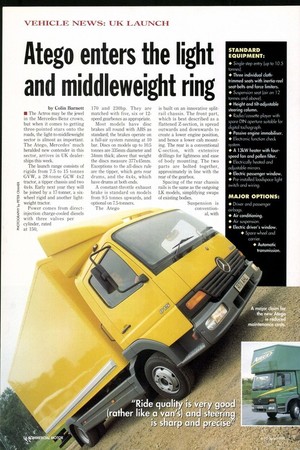Atego enters the light and middleweight ring by Colin Barnett
Page 18

Page 19

If you've noticed an error in this article please click here to report it so we can fix it.
• The Actros may be the jewel in the Mercedes-Benz crown, but when it comes to getting three-pointed stars onto the roads, the light-to-middleweight sector is almost as important. The Atego, Mercedes' much heralded new contender in this sector, arrives in UK dealerships this week.
The launch range consists of rigids from 7.5 to 15 tonnes GVW, a 28-tonne GCW 4x2 . tractor, a tipper chassis and two 4x4s. Early next year they will ei be joined by a 17-tonner, a six. E wheel rigid and another lightweight tractor.
>. Power comes from directinjection ' charge-cooled diesels 8 with three valves per b cylinder, rated at 150, 170 and 230hp. They are matched with five, six or 12speed gearboxes as appropriate.
Most models have disc brakes all round with ABS as standard; the brakes operate on a full-air system running at 10 bar. Discs on models up to 10.5 tonnes are 335mm diameter and 34mm thick; above that weight the discs measure 377x45mm. Exceptions to the all-discs rule are the tipper, which gets rear drums, and the 4x4s, which have drums at both ends.
A constant-throttle exhaust brake is standard on models from 9.5 tonnes upwards, and optional on 7.5-tonners.
The Atego is built on an innovative splitrail chassis. The front part, which is best described as a flattened Z-section, is spread outwards and downwards to create a lower engine position, and hence a lower cab mounting. The rear is a conventional C-section, with extensive drillings for lightness and ease of body mounting. The two parts are bolted together, approximately in line with the rear of the gearbox.
Spacing of the rear chassis rails is the same as the outgoing LK models, simplifying swaps of existing bodies.
Suspension is convention al, with leaf springs, hydraulic shock absorbers and anti-roll bars at both ends with optional air suspension on the rear or both axles. The standard chassis specification includes front and rear spray suppression, rear wings, side and rear under-run protection and side marker lights.
Mercedes stresses that these standard fittings constitute 80kg of the Atego's weight and £350 of its price, which should be borne in mind when making comparisons with the opposition. Good news for multi-drop operators is that 7.5 tonne models get an unusually generous 3,400kg front axle as standard; if that's still not enough, there's the option of a 3,800kg version.
Individual seats The Atego's cab is available in four versions. The basic S day cab includes three individual seats, and easy access through low steps and wide 95° opening doors. The central seat folds to form a work surface.
The S cab features numerous storage locations including cupholders, removable waste bin and more pockets and bins than we have space to list here. Models above 12 tonnes get an air suspension driver's seat as standard.
The SE extended day cab is identical, except that the rear wall is extended by 180mm. Next is a standard-height sleeper cab, the L, which has a 1,950x645mm bunk above 300 litres of stowage space. The final version is the LR high-roof sleeper cab, with 1,920mm of interior height, extensive stor age space above the windscreen and doors, and mounting points for an upper bunk.
A major weapon in the Atego's armoury is a claimed 30% reduction in maintenance and repair costs. This claim is backed up by quotes of 2.6p/km for the M&R contract on a typical Atego 815 covering 80,000km over five years. Major service intervals are 60,000km in most cases, extending to 100,000km on genuine long-distance operation. And just to ensure that your Atego is still around for its next service, a self-arming immobiliser comes as standard.
Most daily checks, including all levels, oil pressure, air tank moisture, air filter condition, brake pads and light bulbs, are carried out automatically at start-up by an electronic monitoring system. This is sophisticated enough to calculate the quantity of engine oil required. Further potential savings arise from touches like the three-piece front bumper, waterproof wiring connectors and insulated-return electrics. STANDARD EQUIPMENT: • Single-step entry (up to 10.5 tonnes).
• Three individual clothtrimmed seats with inertia-reel seat-belts and force limiters.
• Suspension seat (air on 12 tonnes and above) • Height and tilt-adjustable steering column.
• Radio/cassette player with spare DIN aperture suitable for digital tachograph • Passive engine immobiliser.
• Electronic function check system • A 13kW heater with fourspeed fan and pollen filter.
• Electrically heated and adjustable mirrors • Electric passenger window.
• Pre-installed loadspace light switch and wiring.
MAJOR OPTIONS: • Driver and passenger airbags.
• Air conditioning.
• Air suspension.
• Electric driver's window.
• Spare wheel and carrier.
• Automatic transmission.




















































































































